
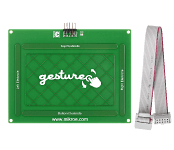
|
Gesture Board Released

The Gesture Board, carrying Microchip's MGSC3130 3D gesture recognition controller, brings a new approach to designing intuitive user interfaces. It's like a touchpad whose input area extends 10cm upwards into space. Users will be able to command an MCU or PC by gesturing with hands and fingers above the board, and by touching and tapping its surface. The board comes with an IDC cable connector. The silkscreen on the back of the board depicts various supported gestures (flicking, drawing circles, airwheels, taps and double taps and so on). The Gesture Board communicates over an I2C interface. For use with with a PC, a special I2C to USB adapter board is available (see 'Accessories').
|
2015/09/18 |

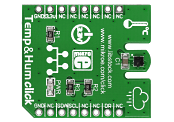
|
Temp-Hum click Released

Temp&Hum click carries ST’s HTS221 temperature and relative humidity sensor. Its temperature measurement accuracy is ±1°C within a 0-60°C range. The precision is increased to ±0.5°C in a narrower range from 15 to 40°C. The highly sensitive relative humidity measurement range is from 0 to 100% with ±6% accuracy (or ±4.5% in the 20-80% range). The measurements are output in 16-bit resolution through the mikroBUS I2C interface. The board uses a 3.3V power supply.
|
2015/09/18 |

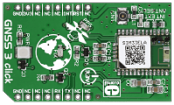
|
GNSS3 click Released

GNSS3 click carries SIMCom's SIM33ELA standalone GNSS module with an integrated antenna (as well as a connector for an external one). GNSS stands for Global Navigation Satellite System, an umbrella term that describes both the United States GPS and the Russian GLONASS global positioning systems. The SIM33ELA module has MTK's high sensitivity navigation engine. It features EPO orbit prediction, AGPS and SBAS ranging (WAAS, EGNOS, GAGAN, MSAS). GNSS3 click communicates with the target MCU through mikroBUS UART pins (RX, TX), with additional functionality provided through RST and INT pins. The board uses a 3.3V power supply.
|
2015/09/10 |

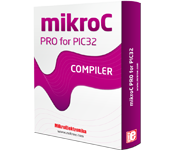
|
PIC32MZ Support Added for PIC32 Compilers

The latest release of mikroE's PIC32 compilers adds support for the new PIC32MZ range of microcontrollers.
|
2015/09/08 |


|
WiFly click (WiFi) Released

WiFly click carries RN-131, a standalone, embedded wireless LAN module. It allows you to connect your devices to 802.11 b/g wireless networks. Preloaded firmware simplifies integration. The mikroBUS UART interface alone (RX, TX pins) is sufficient to establish a wireless data connection (with speeds up to 1 Mbps); the module is controlled with simple ASCII commands (for scanning, authenticating and connecting to Wi-Fi networks). A multitude of networking applications are built in: DHCP, UDP, DNS, ARP, ICMP, TCP, HTTP client, and FTP client. Additional functionality is provided by RST, WAKE, RTSb and CTSb pins. 3.3V power supply only.
|
2015/09/06 |

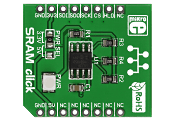
|
SRAM click Released

SRAM click lets you add 1Mbit of additional SRAM memory to your devices, via the 23LC1024 chip. It organizes the memory into 8-bit instruction registers and 32-byte pages. Three operating modes for reading and writing data are available: byte, page, and sequential (the last one allows read/write for the entire memory array). The clock rate for all three modes is up to 20MHz. The board communicates with the target MCU through the mikroBUS SPI interface (MISO, MOSI, SCK, CS) with additional HOLD functionality provided through the default mikroBUS RST pin. SRAM click is designed to use either a 3.3V or 5V power supply.
|
2015/09/06 |

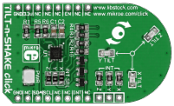
|
Tilt-n-Shake click Released

TILT-n-SHAKE click carries Freescale’s MMA8491Q IC. It's a multifunctional 3-axis digital accelerometer that can also be configured as a 45-degree Tilt sensor. To use it as an accelerometer, keep the EN pin pulled to logic level high. The acceleration data will be outputted to the target MCU through mikroBUS I2C pins (SCL, SDA). The output time is about 700 microseconds, with a 14-bit resolution, ±8 full-scale range and 1 mg/LSB sensitivity. As a Tilt sensor, the click board needs only one output pin — INT (interrupt). Three onboard LEDs will also signal the tilt orientation. TILT-n-SHAKE click is designed to use a 3.3V power supply only.
|
2015/08/28 |

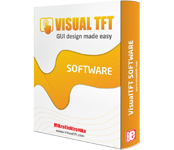
|
Visual TFT 4.5 Released

VisualTFT v4.5 brings a host of new features, including improvements to the way in which code updates are handled between the compiler and Visual TFT, support for FT810 and FT811, and a host of other improvements.
|
2015/08/26 |


|
DC Motor 2 click Released

DC MOTOR 2 click carries the TB6593FNG driver IC for direct current motors. With two pairs of screw terminals (power supply and outputs), the click board can drive motors with voltages from 2.5 to 13V (output current of up to 1.2 amps with peaks up to 3.2 amps). The PWM signal drives the motor while the IN1 and IN2 pins provide binary direction signals that set the direction of the motor (clockwise or counter clockwise), or apply stop or short brake functions. Stop mode cuts off the power supply so the motor continues spinning until it runs out of momentum. Short break brings it to an abrupt stop.
|
2015/08/26 |


|
Arduino Mega click Shield Released

Arduino Mega click shield is an extension for Arduino Mega and any other boards that share its pinout. It's a simple shield with three mikroBUS host sockets that allow you to connect more than 150 different types of click boards to the Arduino Mega. Quickly add functionalities like GSM, GPS, WiFi, ZigBee, Bluetooth, or thunder detection, proximity and color sensing and so on. All sorts of sensors, displays, wireless transceivers, connection ports, encoders, etc are available. Software examples for click boards for MikroElektronika compilers are available on Libstock, giving you a repository of working code to use as it is, or as a starting point for your own projects. The package includes all necessary headers.
|
2015/08/26 |


|
Expand4 click Released

Expand 4 click carries TPCIC6A595, a chip that combines an 8-bit serial-in, parallel-out shift register with an 8-bit D-type storage register.
|
2015/08/26 |

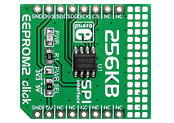
|
EEPROM 2 click Released

EEPROM 2 click carries ST’s M95M02-DR EEPROM chip with 256 KB of memory. The chip has byte and page write speeds equal or less than 10 ms. It's specified for more than 4 million write cycles, with more than 200 years of data retention. The memory, organized as 262144 x 8 bits, has an additional identification page, for storing sensitive application data which can be permanently locked in read-only mode. The board communicates with the target board MCU through the mikroBUS SPI interface (CS, SCK, MISO and MOSI pins). The board is designed to use either a 3.3V or a 5V power supply.
|
2015/08/26 |


|
Comparator click Released

Comparator click, carrying the LM2903 IC, which has two independent precision voltage comparators. Two pairs of screw terminals allow you to connect separate inputs (additional two screw terminals are for GND connections). You can use it either with a single (range of 2.0 VDC to 36 VDC) or dual power supply (from ± 1.0 VDC to ±18 VDC). Two potentiometers are placed between the terminals and the IC. Each input has its own Interrupt pin on the mikroBUS socket (one on the INT pin, the other in place of the mikroBUS AN pin), marked 01 and 02.
|
2015/08/26 |

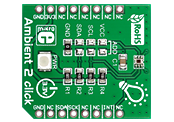
|
Ambient 2 click Released

Ambient 2 click carries TI's OPT3001 Ambient Light sensor. This is a small (2mm x 2mm) single-chip lux meter that measures only the visible part of the light spectrum from any kind of source (mimicking the way humans see light). It does so by filtering out 99% of infrared light. The measurement range of Ambient 2 click is from 0.01 Lux to 83k lux, and a 23-bit resolution. Communication with the target MCU is done through mikroBUS I2C pins, with an additional INT pin which can be used for triggering wake-up events (offloading the MCU).
|
2015/08/26 |

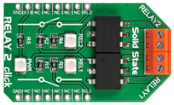
|
Relay 2 click (SSR) Released

Relay 2 click carries two LCA717 single-pole, OptoMOS solid state relays and two screw terminals for connecting the wiring. These relays have a load current of 2A, low maximum on-resistance of just 0.15 Ohms, and a blocking Voltage of 30V. The LCA717 have optically coupled outputs that use the patented OptoMOS technology. Solid state relays enable fast, silent and bounce-free switching. Each relay is coupled with an onboard signal LED. The board is designed to use a 3.3V power supply only.
|
2015/08/14 |


|
TouchKey click (Capacitive) Released

Touchkey click has four capacitive pads powered by TTP224, a touchpad detector IC. Capacitive buttons like these can be toggled even when placed under a layer of glass or paper.
|
2015/08/14 |


|
ADC2 click Released

ADC 2 click carries MCP3551/3, which is a 22-bit ADC with automatic internal offset and gain calibration. This high precision analog-to-digital converter has total unadjusted error of less than 10 ppm, and low-output noise of 2.5 µV RMS. The board carries two pairs of screw screw terminals: VIN- for bringing in reference voltage, VIN+ for the positive voltage. VCC out and GND are output voltages. The click communicates with the target board through mikroBUS CS, CSK and MISO lines. Can use either a 3.3V or 5V power supply.
|
2015/08/14 |


|
WiFi4 click Released

WiFi 4 click carries SPWF01SA, a complete standalone WiFi module with a single-chip 802.11 b/g/n transceiver, a 32-bit STM32 MCU, along with a built-in 2.4 GHz ISM band antenna. The onboard module has 1.5 MB of internal flash and 64 KB of RAM, plus a fully integrated TCP/IP protocol stack with added web server and application service capabilities. WiFi4 click communicates with the target MCU through the mikroBUS UART interface, but the board also features additional 14 GPIO pins. Uses a 3.3V power supply only.
|
2015/08/14 |


|
Nano GPS click Released

Nano GPS click carries the Nano Hornet module from OriginGPS. It's the smallest GPS module with an integrated patch antenna (measuring just 10x10x3.8mm). Hence, Nano GPS click is also the smallest of all MikroElektronika GPS click boards. Despite its size, it offers superior sensitivity and outstanding performance, with time to first fix (TTFF) of less than 1 second, accuracy of approximately 1m, and tracking sensitivity down to -163dBm.
|
2015/08/14 |


|
Button R click Released

Button R click is the simplest solution for adding a single pushbutton to your design. The button itself is transparent, 6.8mm in diameter and has a red LED backlight. When pressed, it sends an interrupt signal to the target board microcontroller. The backlight LED is controlled separately through the mikroBUS PWM pin, so you can program all kinds of patterns (varying level of light intensity or rate of blinking on subsequent button presses). The board can use either a 3.3V or a 5V power supply.
|
2015/08/14 |

|

